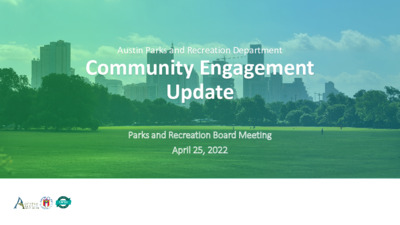B4-1: Community Engagement Presentation — original pdf
Backup

Austin Parks and Recreation Department Community Engagement Update Parks and Recreation Board Meeting April 25, 2022 Outline • History of City of Austin Community Engagement (CE) • PARB Question: “How is Community Engagement data used by PARD in the planning process?” • Present CE Challenges • Questions 2 City History • Pre-2009: Community engagement varied per projects. • Most followed legal requirements (i.e. codified public hearings) • Some larger projects held community meetings. COA lacked standard practices for community engagement • 2009: Communications and Public Information Office (CPIO) hires first employee dedicated to community engagement though no specific title exists. • 2011: CPIO begins offering CE support to City Departments (with their one position). • 2010-Present: CPIO develops tools, standards, values and other operations pertaining to COA’s community engagement approach. Staff expands to only three (3) full-time positions. • January 2015: Austin City Council created Task Force on Community Engagement • June 2016: CPIO creates first community engagement job title, Community Engagement Specialist • September 2017: CPIO creates Community Engagement Consultant title • Present: CPIO operates with only 3 CE positions 3 Department History • 2017: PARD’s Marketing and Communication Unit (formerly Public Information and Marketing) changes name to Communications and Engagement Unit (CEU) to reflect shifting work focus. • 2017: CEU reclasses Public Information Specialist position into Community Engagement Specialist • 2017-2022: One FTEs dedicated to community engagement 4 PARB Question: “How is data used by PARD in the planning process?” • Information gathered from CE is aggregated and presented to project manager(s) and consultants or program/administrative initiative lead. • Project managers help interpret data and review consultants' interpretation and application of input and design choices. • Plans are presented to communities and refined in an iterative process. • Program/Administrative staff review input as part of decision-making process these decisions are reflected in administrative document revisions, program changes, and in some cases community processes (i.e., naming) • The Department continues to evaluate and evolve to ensure opportunities to improve consistency and transparency. 5 PARB Question: “How is data used by PARD in the planning process?” Community feedback on final plan Parks and Recreation Board City Council Surveys / community feedback during plan development Park Vision Plan Walter E. Long Metro Park Strong advocates for a golf course on the northeast part of the park associated with a public/private partnership Continued push to include the golf course to promote economic development in and around the Metro Park The Board voted unanimously to exclude the golf course in the plan John Trevino Jr. Metro Park Some community members desired a skate park and bike pump track Strong community desire against these traditionally urban amenities Final plan compromised with an adventure play area geared toward recreation for older teenagers (13+) Holly Shores / Edward Rendon Sr. Park at Festival Beach New ped/bike bridge crossing LBL to the island in the lake then to the parkland to the south No ped/bike bridge crossing LBL to the island then to the parkland to the south Council did not support the decision of a golf course or a public/private partnership Adventure play retained as part of overall approved plan Language in the plan stated “No new ped/bike bridge until IH-35 and Pleasant Valley ped/bike crossing are improved” 6 PARB Question: “How is data used by PARD in the planning process?” Park Vision Plan Surveys / community feedback during plan development Community feedback on final plan Parks and Recreation Board City Council Givens District Park New off-leash dog park area Existing longtime Beverly S. Sheffield Northwest District Park Strong community desire to increase the health and visual appeal of the pond WPD engineers recommended an expanded pond to increase habitat and improve pond health The final plan does not include an off-leash area The final plan retains the pond layout with no tree removals N/A N/A residents opposed to an off-leash area in the park Due to existing pond disruption and removal of existing mature trees, the community feedback called for the existing pond layout to remain 7 Present CE Challenges • Staffing • Past, Present, Future • Consultants • Knowledge Retention • Community Relationships/Trust • Consistency • Prime vs. Sub • Cost limitations • Defining Standards 8 Questions